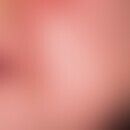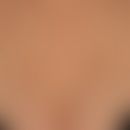Synonym(s)
HistoryThis section has been translated automatically.
Kraus 1913; Aractingi et al. 1991
DefinitionThis section has been translated automatically.
Frequent transient infectious pustulosis of the infant (Chadha A et al. 2019). After a latency of 2-3 weeks after birth, newborns develop acne-like symptoms with the appearance of follicular papulopustules on the face, neck and also on the capillitium without impairment of the general condition.
You might also be interested in
Occurrence/EpidemiologyThis section has been translated automatically.
Frequent occurrence. Malassezia furfur can be detected at birth in 11% of newborns and at the age of 3 weeks in 52% of newborns. Up to 75% of colonized newborns develop pustules of varying severity.
EtiopathogenesisThis section has been translated automatically.
Pityrosporum ovale is a lipophilic yeast that lives saprophytically in areas of the infant rich in sebaceous glands. The pathogens are transmitted from mother to child during and after birth.
LocalizationThis section has been translated automatically.
The apparitions mainly affect the face, the neck and the capillitium.
ClinicThis section has been translated automatically.
After a latency period of 2-3 weeks, an acute, "acneiform pustulose" with tiny, follicular, yellowish pustules and reddened papules occurs in the otherwise clinically inconspicuous newborn in the area of the capillitium, neck and in the seborrhoeic zones of the face. Malassezia furfur is regularly detected from pustule swabs, which can be assessed natively (see below pityriasis versicolor). In contrast to acne infantum, comedones are completely absent.
DiagnosisThis section has been translated automatically.
Microscopic detection of the pathogens in the pustular smear.
Differential diagnosisThis section has been translated automatically.
- Erythema neonatorum: Occurrence earlier. No pustular formation.
- Miliaria cristallina: No pustular formation. Smallest, water clear vesicles.
- Milia of the newborn: May already be present at birth; no pustules, solid, deep-seated, firm, yellow papules, no acute course; rupture usually after a few weeks.
TherapyThis section has been translated automatically.
- A therapy is not necessary, since the disease is self-limiting.
- If treatment is urgently required: Apply 2% ketoconazole cream(Nizoral cream) 2 times/day for 2 weeks on the affected areas.
- Alternatively Ciclopiroxolamine (e.g. Batrafen Gel). Wash mother's head and hair several times with ketoconazole solution.
Progression/forecastThis section has been translated automatically.
Note(s)This section has been translated automatically.
The apparitions used to be erroneously called "Acne neonatorum" and were thus aetiologically misunderstood. They no longer occur in older infants despite increasing colonisation with Malassezia furfur.
This frequent transient infant dermatosis must be distinguished from Acne neonatorum, the infantile acne(Acne infantum), both of which occur with acne-typical changes (inflammatory papules, pustules, comedones).
LiteratureThis section has been translated automatically.
- Ayhan M et al (2007) Colonization of neonate skin by Malassezia species: relationship with neonatal cephalic pustulosis. J Am Acad Dermatol 57:1012-101
- Bergman JN et al (2002) Neonatal acne and cephalic pustulosis: is malassezia the whole story? Arch Dermatol 138:255-257
- Bernier V et al (2002) Skin colonization by Malassezia species in neonates: a prospective study and relationship with neonatal cephalic pustulosis. Arch Dermatol 138: 215-218
Chadha A et al (2019) Common Neonatal Rashes. Pediatr Ann 48:e16-e22.
Crespo Erchiga V, Delgado Florencio V (2002) Malassezia species in skin diseases. Curr Opin Infect Dis 15: 133-142
- Rapelanoro R et al (1996) Neonatal Malassezia furfur Pustulosis. Arch Dermatol 132: 190-193
- Zuniga R et al (2013) Skin conditions: common skin rashes in infants.skin conditions: common skin rashes in infants. Skin conditions: common skin rashes in infants. FP Essent 407:31-41.
Incoming links (8)
Acne infantum; Acne neonatorum; Milia; Milia of the infant; Neonatal malazessia furfur pustulosis; Newborns, skin changes; Pustulose neonatal cephale; Sebaceous gland hyperplasia neonatal;Outgoing links (9)
Acne infantum; Acne neonatorum; Ciclopirox; Erythema neonatorum; Ketoconazole; Malassezia furfur; Milia; Miliaria; Pityriasis versicolor (overview);Disclaimer
Please ask your physician for a reliable diagnosis. This website is only meant as a reference.





